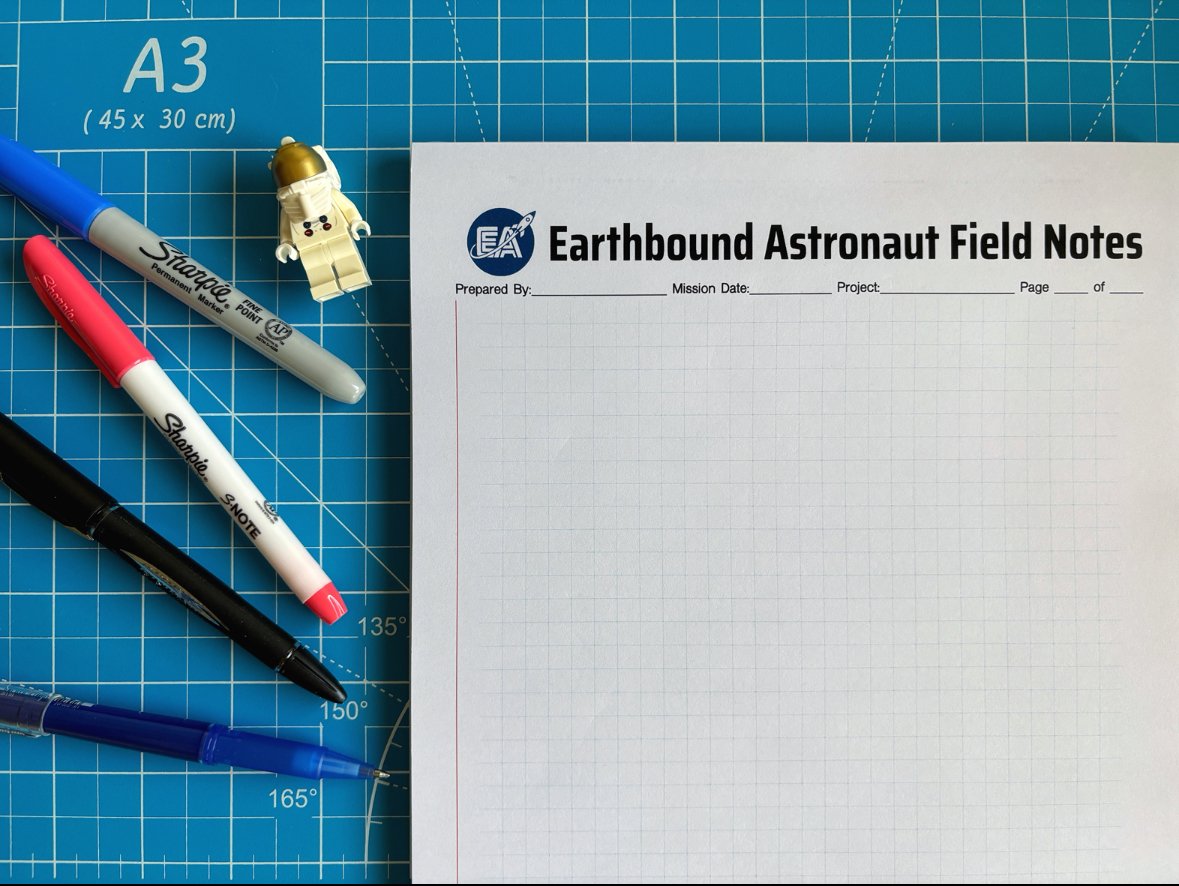
Earthbound Astronaut Field Notes
A grid-lined notepad for dreamers and designers. Composed offline, here on Earth.
What is this?
This is a simple notepad. 50 sheets, grid-lined, with enough structure to keep your thoughts aligned but also enough blank space to go wherever your mind wants to wander. It’s small enough to toss in your messenger bag, but large enough to sketch, write, or map out something you’ve been turning over in your head.
Why I created it
A while back, I caught myself about to buy another blank notepad online. This one was space-themed, designed by Tom Sachs. Beautiful, intentional, and not even particularly expensive. Over the years, I’ve also bought plenty of generic notepads from stationary stores and Amazon.
But then I paused.
Earlier in the year, I’d written an essay called Stephen the Creator, about the difference between collecting creative tools and actually making something with them. I realized this was my chance to put that idea into practice.
A few weeks later, I followed up with The Earthbound Astronaut Project, reflecting on what it means to stay curious and adventurous while moving through life on Earth. In that piece, I wrote about journaling. Taking note of things that spark your attention, big or small.
So instead of adding another mass-produced item to my cart, I wondered: What if I made my own?
What would it look like to turn an idea into something physical?
What I learned
This was my first foray into design software. I chose Affinity Publisher partly because you can still buy it outright. No recurring license or monthly bill like Adobe.
Sure, I probably could have whipped up a grid in Microsoft Word and called it a day. But when you’re chasing down a “what if” in your own head, it’s never that simple. (And hey—Tony Stark built an arc reactor in a cave with a box of scraps, so let me have this.)
Even with the right tools, the learning curve was steep. CMYK. Vector logos. Grid spacing. Margins and bleed areas. Even the concept of “non-reproducing blue” felt like a mystery until I attempted to photocopy my first draft and realized: modern copiers are too good. The blue reproduced just fine.
Thankfully, there’s no shortage of tutorials online for tools like this, and AI proved surprisingly helpful for navigating technical roadblocks. That said, my obsessive tweaking of line weights and colour codes nearly fractured my professional relationship with ChatGPT. (We’re patching things up, but I can still sense a tone it takes when I’m not satisfied.)
As I built the grid, margins, and borders, I found myself thinking about boundaries. Not just on the page, but in the creative process itself. How firm should they be? A single or a double line? What line weight feels like a gentle guide versus an impenetrable wall? It struck me that this is the balance we’re always trying to find when we make something. Enough structure to give shape, but enough openness to let ideas breathe.
I fumbled through the process over a period of several weeks. Adjusting colours. Tweaking the grid style. Sampling paper weights. I made countless small decisions that felt impossibly specific at the time. But little by little, the design came together.
And as it came together, so did the bill. The Affinity software, test printing colour pages, padding. All told, I could have bought a lifetime of notepads on Amazon for what this cost. But the process, this creative journey I’ve been on, has been about investing in myself. Learning. Discovering. Taking the first step without knowing if there would even be a second, or where it might lead. No instructions or a roadmap. Just trial and error until it felt right.
Why it matters
We live in a time where our devices can do almost anything. I grew up watching Star Trek, fascinated by the PADD devices the crew carried. And now here we are, with iPads that are infinitely more capable. But, more and more lately, I’ve found myself craving physical tools again. Objects with a single, simple purpose.
The Earthbound Astronaut Field Notes is one of those tools. For me, it’s a reminder that you don’t need a spaceship to explore. You just need a place to design, observe, jot, and reflect on the world around you.
It’s also a reminder of something I’m still learning: when is something done? When is it good enough? In the professional world, the answer usually comes from someone else. A boss, a client, a deadline. But when you’re making something for yourself, there’s no external finish line. At some point you just have to let it out into the world, imperfections and all, and trust that it’s ready.